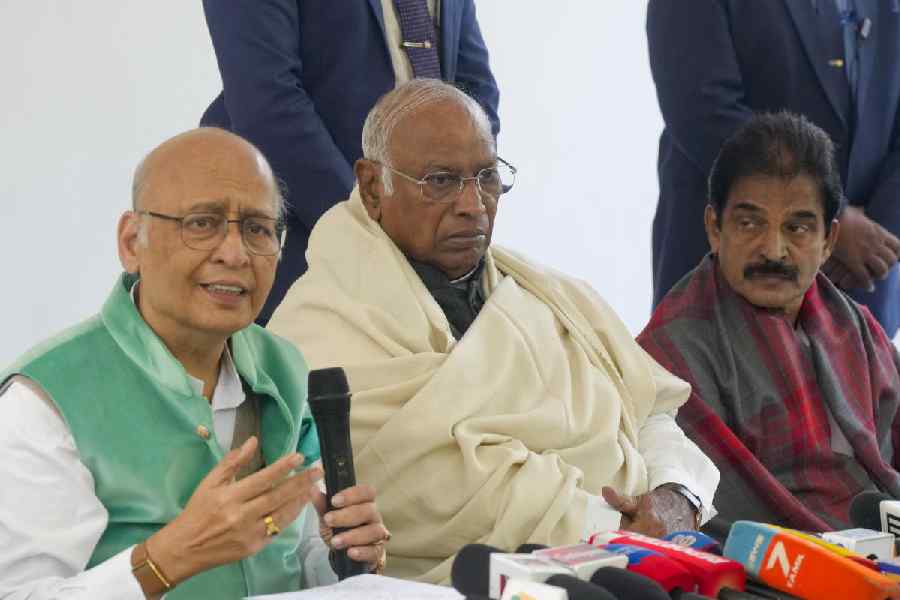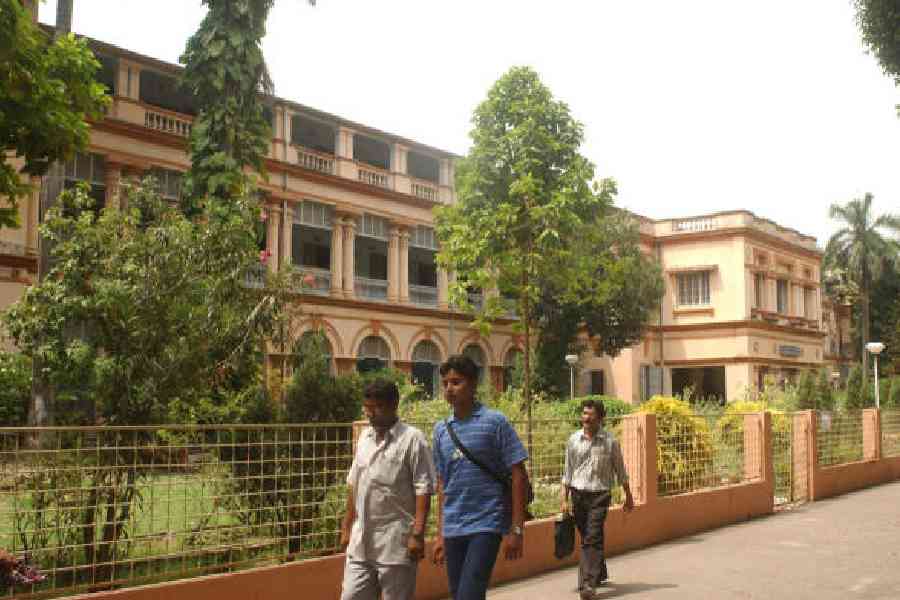|
|
It is not as though the striking blonde wielding a heavy camera (played by Candice Bergen in Richard Attenborough’s Gandhi) at political meetings was initially a ‘people’ photographer. In 1927, Margaret Bourke-White was spotted by Henry Luce, the publisher of Time who had seen her architectural and industrial images and promptly decided that she should be hired for his new venture, Fortune. In six years’ time, he had launched the 20th-century publishing icon, Life — and Margaret was the first photojournalist to be hired. There was no looking back for her. Images from World War II, the liberation of Buchenwald, and Joseph Stalin at the Kremlin firmly established Bourke-White’s reputation not only as a photographer but also as one with indefatigable energy, initiative and, of course, the brashness required to elbow one’s way in — literally. It was hardly surprising that Life commissioned her to photograph the exchange of populations that followed the Partition of India.
Bourke-White was born in 1904 to a Polish immigrant father of Jewish descent and an Irish Orthodox Christian mother. Her maternal grandfather had been a carpenter. In the pre-Depression years in a country where virtually anybody could become anything, Margaret was soon in college and, by her senior year, knew that she loved taking photographs. When Luce spotted her, she had been successful at experimenting with magnesium flares for lighting: doing the unexpected, taking risks for just that compelling visual or story are what fireside reminiscences are made of. Though Bourke-White did not live to have grandchildren who would have been avid listeners, she did write Halfway to Freedom, her report and photographs of “the new India”.
Several of Bourke-White’s photographs of those tumultuous days have recently been reproduced — in a 2006 version of Khushwant Singh’s enduring classic Train to Pakistan and in Witness to Life and Freedom: Margaret Bourke-White in India and Pakistan — conceptualized by Pramod Kapoor, who has also done the text linking chosen images from the Getty archives. Kapoor includes a chapter from Vicki Goldberg’s biography of the photographer that helps contextualize the woman and her times. When Bourke-White arrived in India in March 1946, she knew that photographing Mahatma Gandhi was a priority; it was difficult to get past his obdurate secretary who insisted that she had to know how to spin before anything else. Goldberg writes that “Margaret neither knew how to spin nor cared... [but] because her pictures had to be on the plane that night” she had no option but to learn. Soon, she was allowed into his presence and was to take an image that has been “endlessly reproduced”: the Mahatma poring over papers on his lap while the spinning wheel occupies the left foreground. The photographer was to go on to take many more shots of the man who soon gave her the nickname of “the torturer”.
Mohammed Ali Jinnah’s Direct Action Day saw her in the “fetid alleys of Calcutta”, photographing the dying and the dead. Her images immediately found a double-page spread in Life — while those of an Associated Press photographer were turned down with the terse message, “Your bodies inedible for British consumption.” And then her searing photographs of that relentless journey across new borders. Bourke-White was to be documenting a land torn asunder in scenes that she wrote were “straight out of the Old Testament”. She commented in Halfway to Freedom that, as she travelled with the migration, her “respect for Moses grew”. But, she added, these people had no Moses, and despite her immense respect for the Mahatma, for her, he was not Moses; nor, certainly was Jinnah.
Bourke-White’s photographs of Gandhi are not only brilliant in their composition and use of chiaroscuro, but also the kind that makes the viewer feel that she could have been one of the crowd. They are vibrant, vital, catching the odd half-smile of a spectator, the glint of his sharp eyes as Gandhi lies fasting or his concentrating on getting into a car as he leaves Birla House. The chauffeur stands upright and looks discreetly into the middle distance while a follower — or supplicant — stands at a distance, his body language and slight stoop conveying his awe tinged with apprehension. The front wheel and left handlebar of a cycle parked against a wall that were not cropped add to the general untidy feeling around the composition; and yet one returns to it time and again. As Bourke-White’s admiration grew for the man whom she likened to a “great white mushroom on legs, under the huge wet Turkish towel on his head”, so did her portfolio on Mahatma Gandhi, his prayer meetings, his walks in Sabarmati Ashram and of him on his last fast. She was possibly the last to interview and photograph him on January 29, 1948, the day before his assassination.
While in India, Bourke-White lived many lives: she had the style and acumen to be able to entertain at the same table “Hindu nationalists. Moslem separatists, Communists, British diplomats, and maharajahs”. The iconic photographer, Sunil Janah, became her assistant and the journalist, Frank Moraes, fell hopelessly in love with her. She took many portraits of the rich and famous — various maharajas at the Chamber of Princes — some more awake than others, Subhas Chandra Bose smiling self-consciously, Bhimrao Ambedkar looking a tad suspicious while Jawaharlal Nehru poses with a cigarette in an elegant holder and Jinnah’s “deep-sunk eyes” are “pinpoints of excitement”. Some were sensitively composed, others taken when her subjects were not aware of her. Hence the raised finger of the communist leader, Godavari, at a meeting, Rajkumari Amrit Kaur’s furrowed brow as her pen hovers over a word, and while Sarojini Naidu beams at the photographer, the deferential admiration in the half-turned face of the Maharani of Nabha is not overlooked by the camera. Bourke-White’s use of the profile helped in capturing the occasional untoward look, the slightly furtive gesture, the grimace. She had few qualms in doing whatever was needed to get her image, helped by serendipity.
On the great migration trail, Bourke-White was unstoppable, her anonymous subjects hapless victims of a political drama being staged elsewhere. Dead eyes stare out of from between the spokes of a cart wheel, an emaciated dog picks at a body or rows of those who have little option but to lie down to await “death in a swarm of flies”. The power in Bourke-White’s imagery of those endless blood-filled, scorchingly hot days is the stuff that goose pimples are made of. Lee Eitington, a journalist who went to the Punjab with her in August 1947, was app-alled at her insouciance in asking a group of terrified refugees to repeat their action of flight time and again until she felt that she had the right visuals. She was, of course, following a not unknown practice. Dead bodies and bones rearranged for effect have a long tradition in war and disaster photography — in memorializing the aftermath of 1857, Felice Beato had few compunctions in moving the odd skeleton or severed limb around. Bourke-White had little time for Eitington’s protests, offering instead money to her traumatized subjects; she brushed aside the suggestion that was not what was needed — but rather, the people had to move on. Wryly, the less hardened journalist commented, “That’s why she was such a good photographer. People were dying under her feet. She thought herself a great humanitarian, but when it came to individual people....” It was the ultimate irony of fate that the woman with boundless panache and courage died of Parkinson’s in 1971 — a disease that Bourke-White had learnt to live with for almost two decades. True to her character, she worked hard at understanding her illness and collaborated with a colleague to publicize the experimental surgery that she had undergone; the world applauded Bourke-White’s new work. Perhaps the most famous photojournalist of the era, Bourke-White’s death came at a time when, as Pramod Kapoor points out, the genre was being reluctantly edged out by the small screen and the immediacy of moving images.











